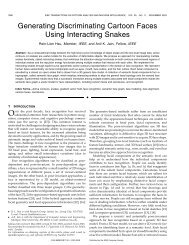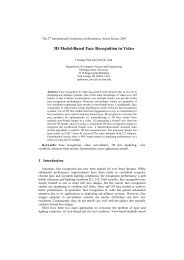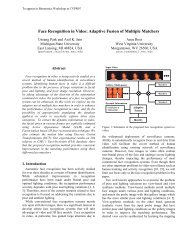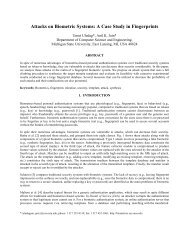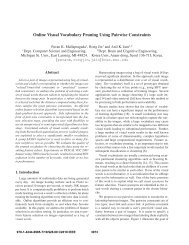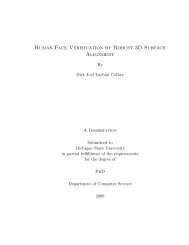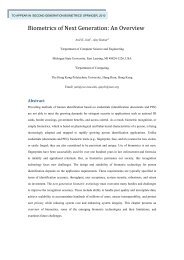Face Detection and Modeling for Recognition - Biometrics Research ...
Face Detection and Modeling for Recognition - Biometrics Research ...
Face Detection and Modeling for Recognition - Biometrics Research ...
You also want an ePaper? Increase the reach of your titles
YUMPU automatically turns print PDFs into web optimized ePapers that Google loves.
eling. However, they did not implemented the recognition module. Atick et al. [107]<br />
proposed a reconstruction method of 3D face surfaces based on the Karhonen-Loeve<br />
(KL) trans<strong>for</strong>m <strong>and</strong> the shape-from-shading approach. They discussed the possibility<br />
of using eigenhead surfaces in face recognition applications. Yan et al. [108] proposed<br />
a 3D reconstruction method to improve the per<strong>for</strong>mance of face recognition by making<br />
Atick et al.’s reconstruction method rotation-invariant. Zhao et al. [109] proposed<br />
a method to adapt a 3D model from a generic range map to the shape obtained from<br />
shading <strong>for</strong> enhancing face recognition per<strong>for</strong>mance in different lighting <strong>and</strong> viewing<br />
conditions.<br />
Based on our brief review, we believe that the current trend is to use 3D face<br />
shape explicitly <strong>for</strong> recognition.<br />
In order to efficiently store an individual’s face,<br />
one approach is to adapt a 3D face model [72] to the individual.<br />
There is still a<br />
considerable debate on whether the internal recognition mechanism of a human brain<br />
involves explicit 3D models or not [49], [110]. However, there is enough evidence to<br />
support the fact that humans use in<strong>for</strong>mation about 3D structure of objects (e.g.,<br />
3D geometry of a face) <strong>for</strong> recognition. Closing our eyes <strong>and</strong> imagining a face (or a<br />
chair) can easily verify this hypothesis, since the structure of a face (or a chair) can<br />
appear in our mind without the use of eyes. Moreover, the use of a 3D face model<br />
can separate both geometrical <strong>and</strong> texture features <strong>for</strong> facial analysis, <strong>and</strong> can also<br />
blend both of them <strong>for</strong> recognition as well as visualization [67]. Our proposed systems<br />
belong to this emerging trend.<br />
46



